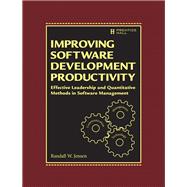Superior software productivity requires a relentless focus on people, motivation, and communication. In Improving Software Development Productivity, world-renowned software engineering expert Dr. Randall W. Jensen introduces a proven, quantitative approach to achieving this focus. Jensen helps you measure your organization’s capacity and productivity, and then use that information to improve multiple facets of developer and team performance, and to build more accurate estimates and schedules.
Focusing on management as the principal cost and schedule driver in software projects, he demonstrates a powerful tool based on his Jensen II (Seer) model: the model that underlies many leading software estimation tools. Through real case studies, you’ll learn how to predict the productivity impact of any major management decision, and quantitatively support a transition to “extreme” or “agile” software development environments.
For decades, Jensen has been the industry’s go-to expert on improving software project productivity. This book distills his insights and gives you the tools and knowledge to apply them.
This book will help you
- Recognize the centrality of communication and culture, and translate this awareness into quantitative improvements
- Predict the impact of changes in personnel, management style, development environments, product constraints, and technologies
- Optimize decision making throughout a project’s lifecycle, and avoid counterproductive changes
- Understand modern estimating models and parameters, so you can apply them more effectively
- Formulate more accurate and useful estimates with leading tools such as Sage, REVIC, COCOMO II, and SEER-SEM
- Maintain firmer control over costs and timeframes in agile or extreme project environments
Register your book for access to the Capability Calculator, a Microsoft Excel tool created by the author and based on the Jensen II (Seer) model. Go to informit.com/title/9780133562675.









